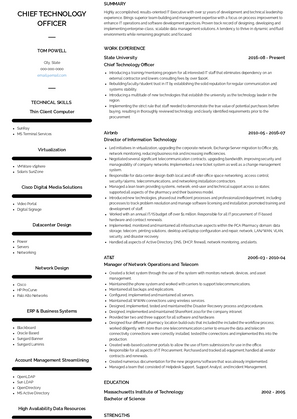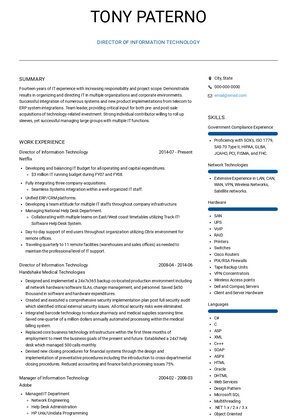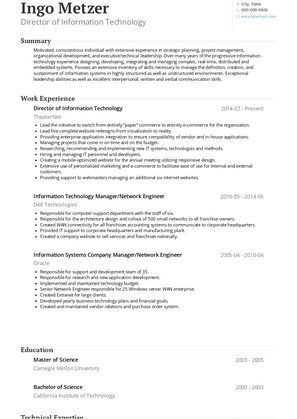Chief Technology Officer Resume Examples [+ 3 Samples]
This page provides you with Chief Technology Officer resume samples to use to create your own resume with our easy-to-use resume builder. Below you'll find our how-to section that will guide you through each section of a Chief Technology Officer resume.



Overview
Chief Technology Officers like you occupy executive high positions in a business and are responsible for solving the organization's technological and scientific issues. We both know it’s no easy fit, right?
We can even add the fact that this is an extremely competitive industry, and boom, we have scared you. Sorry, we didn’t mean to!
Don’t worry though, we are here to help you create the best Chief Technology Officer resume ever, thanks to the best CTO resume sample in the web!
Employers want to see a resume that speaks to them. CTOs like you require an excellent and standout resume to convince the recruiter that you are the one, even just by one look at your resume.
What we can do is to help you create a resume that allows you to get to the next level as a chief technology officer; we will navigate you through the different technicalities involved in writing a good resume.
We can help you as we have already inspired over three million customers so far with our professional resume samples! Let us get you the job you have always dreamt of! We can already see you sitting in your future office!
Also, checkout our collection of technology resume examples:
- Executive Director Resume Examples
- Executive Resume Examples
- CEO Resume Examples
- CIO Resume Examples
- Co-founder Resume Examples
How to write a CTO resume?
To write a CTO resume that stands out, follow these steps:
- Select the right Chief Technology Officer resume format.
- Show that you can provide tech mentorship and build an amazing engineering culture.
- Highlight how you have previously helped companies scale their tech infrastructure to meet business objectives.
- Breakdown your relevant experience when it comes to security, migration, scalability, QA, etc.
Note: Leverage AI to level-up your resume - Try our AI Resume Builder
As a CTO you’re going to need to have excellent skills in technology and keep yourself constantly updated with the latest technological development which you probably already know. However, you have to try and illuminate these skills in your resume. If you can show you have good people skills and are looking into ways to improve yourself professionally then recruiters might just want to take a second look at you.
So, when creating a resume for the position of CTO, you’re going to have to start off by creating a format which makes the resume appealing. You probably think opting for several fonts with several bright colors is a good idea but you’d be wrong. Recruiters aren’t interested in resumes they can’t read or find it difficult understanding, they want simplicity.
Finally, watch the type of tone you use. It’s easy to say you’re trying to be funny but it might not come across as funny. What is more, recruiters judge you by how you write and what you write and they might not be impressed with a resume full of jokes. Recruiters want a serious candidate.
And don’t forget to save your resume as a .pdf instead of Microsoft Word: you want to keep that layout intact!
The CTO Resume Summary Section
Resumes without summaries are often put to one side. It shouldn’t be that way but many employers are looking at methods to cut back on potential candidates and sometimes the summaries can do the trick. It’s really simple to create a summary and certainly it’s something you should take a moment to construct.
It doesn’t have to be perfect, we know that better than anyone but what we hopefully can help with is creating a summary that answers the question of who you are. A summary isn’t much but it might just be the extra step to unlock an interview.
DO (Summarize your employment)
- Talk about your past jobs, including a brief job description.
- Show real results of past achievements.
- Use lots of positive words and verbs.
DON’T (Summarize your life)
- Use buzzwords – they aren’t needed.
- Make it all about your social life.
- Use a foreign language to show your bilingual talents.
Chief Technology Officer Resume - Work Experience Section
Employers who reach your work history are usually more impressed by what they have seen so far. That’s actually a good thing for you simply because they have some belief you’re the one they need. However, since they have reached this far, you don’t want to mess it up now. You have to ensure you add a good array of history so that employers can see what you’ve done in the past.
What to add on a resume? Firstly, are you employed? If so, you should be adding that onto the resume as it’s your latest job and you potentially have a few references to come from there. However, it doesn’t hurt to list several previous jobs as it brings together a brief work history. A lot of people don’t think about adding work history when applying for a position and yet it’s quite an important factor to consider.
Why not read a few more tips about what to add on your work history:
Do (Summarize your work history)
- Use bullet points.
- Use a neutral but professional tone.
- Use problem solving skills to show what the employer is getting.
DON’Ts (Summarize your relationship history)
- Overload information into your work history.
- Stuff in a thousand references, one or two should suffice.
- Be arrogant in how you describe your past jobs.
Need more tips on writing an efficient work experience section for a great CTO? Check out our detailed resume guide.
How to List Education on Your CTO Resume
You might not be overly impressed with your own educational background but that doesn’t mean to say you shouldn’t add it to your resume nonetheless. All resumes should have some form of education on them so employers know a little more about your core education. However, you aren’t limited to your time in high school or even junior college.
You could actually list a variety of training courses you’ve completed. Any form of education which can be drawn onto your job could potentially be added. Education shows a little more about your training and your background which most employers could find useful.
The following are three very important elements of your education that must be added:
- Which institutes you’ve studied at.
- What subjects you have studied.
- What the outcomes of your studies were.
The amount of information you put into your education section doesn’t have to be overly long, it can be fairly short but effective to appeal to employers. Yes, it’s useful to be thorough in your education but at the same time, you don’t want to drown the employer with lots of information. You need to get a nice balance worked out.
Best CTO Resume Skills
One thing which you might not actually be aware of is some employers are screening applicants so they source the most relevant ones. That essentially means you have to use the right skills and talents on your resume. If you don’t put in the skills which employers are looking for, you might not get an interview so it’s best to think about the type of talents or skills you have which employers will find useful.
We can help; it’s really a lot less complicated than it appears to be. So, what you want to do is create a small brief of talents and skills which you could use. These skills can be hard skills or soft skills and if you can show the potential employer what you have to offer, you might appeal to them a little more. That’s why skills should be noted down on the resume.
| Soft Skills | Hard Skills |
|---|---|
| Technological Understanding | Coding |
| Team Work | Strategic Thinking |
| Leadership and Communication | Analytical Thinking |
| Strong mathematical aptitude | Technical planning (robustness, stability, scaling, security) |
| Problem Solving | Knowledge of IT business regulatory |
How to Demonstrate Technology Leadership and Strategy
As a CTO, your primary role is to align technology with business goals. Show how you’ve developed strategies to drive business innovation, improve scalability, and solve company-wide challenges.
Steps to Showcase Technology Leadership:
- Detail your strategic initiatives: Include examples where you built or scaled tech infrastructures.
- Include tangible results: Highlight metrics that show impact.
Examples:
- "Built and implemented a scalable microservices architecture, increasing product performance by 30%."
- "Developed and executed a 5-year technology strategy that aligned IT initiatives with revenue growth of 20%."
How to Highlight Digital Transformation Initiatives
Digital transformation demonstrates your ability to evolve legacy systems and adopt cutting-edge technologies.
Steps to Highlight Digital Transformation:
- Focus on enterprise-level projects: Mention system upgrades, cloud migration, and new technologies.
- Emphasize business outcomes: Show how transformation improved efficiency, customer experience, or profitability.
Examples:
- "Spearheaded an enterprise-wide cloud migration, reducing infrastructure costs by 35% while enhancing scalability."
- "Led the integration of AI and IoT platforms, improving product delivery time by 25%."
How to Showcase Cybersecurity and Risk Management Expertise
Security is a top concern for CTOs. Highlight how you’ve implemented risk management frameworks and secured data integrity.
Steps to Showcase Cybersecurity:
- Focus on initiatives: Include compliance achievements and security frameworks (e.g., NIST, ISO).
- Link outcomes to risk reduction: Provide measurable improvements.
Examples:
- "Implemented a company-wide zero-trust architecture, mitigating unauthorized access risks by 40%."
- "Achieved SOC 2 compliance, ensuring robust data security for enterprise-level operations."
How to Feature Innovation and Emerging Technologies
A CTO must embrace innovation to drive competitive advantage. Highlight projects where you integrated AI, machine learning, blockchain, or automation tools.
Steps to Showcase Innovation:
- Mention emerging technology adoption: Focus on AI, ML, IoT, or blockchain use cases.
- Link to measurable business value: Show how innovation improved processes.
Examples:
- "Introduced AI-driven predictive analytics, reducing operational downtime by 20%."
- "Pioneered the adoption of blockchain technology, improving transaction transparency and cutting errors by 15%."
How to Highlight Technical Team Leadership and Culture Building
Leadership and team development are key for CTOs. Focus on how you built high-performing teams, mentored talent, and improved culture.
Steps to Show Leadership:
- Mention team size and structure: Highlight the scale of your leadership.
- Show cultural improvements: Include retention rates or productivity gains.
Examples:
- "Reorganized and scaled an engineering team of 50, improving project delivery by 30%."
- "Implemented a mentorship program, reducing attrition rates by 15% and increasing team satisfaction scores."
How to Demonstrate Financial Management and Cost Optimization
CTOs are responsible for balancing technology investments and financial goals. Showcase your cost-saving initiatives and ROI achievements.
Steps to Highlight Financial Management:
- Focus on cost reductions: Include examples of budget optimization.
- Show ROI on investments: Detail business gains from IT spending.
Examples:
- "Reduced IT operating costs by 25% through vendor consolidation and cloud adoption."
- "Increased ROI by 30% by implementing DevOps automation tools, reducing deployment times."
How to Highlight Vendor and Stakeholder Management
Managing external partnerships and stakeholders is critical for success in CTO roles.
Steps to Showcase Vendor Management:
- Mention vendor negotiations and partnerships: Include cost savings or quality improvements.
- Highlight alignment with stakeholders: Show cross-functional collaboration to achieve company goals.
Examples:
- "Negotiated a $2M annual savings with cloud service providers while improving uptime reliability to 99.9%."
- "Aligned with C-level stakeholders to deliver a 3-year technology roadmap improving overall digital readiness."
How to Showcase Data and Business Intelligence Initiatives
CTOs must leverage data for business growth and informed decision-making. Highlight your implementation of BI tools and analytics.
Steps to Showcase BI Initiatives:
- Mention tools: Tableau, Power BI, and advanced analytics platforms.
- Show impact on decision-making: Quantify improvements in operations or strategy.
Examples:
- "Implemented real-time BI dashboards using Tableau, reducing decision-making time by 20%."
- "Leveraged predictive analytics to increase customer retention rates by 15%."
How to Highlight Your Education and Certifications
Certifications and advanced education demonstrate your expertise and professional credibility.
Steps to Include Certifications:
- Add a dedicated certifications section: Include credentials relevant to CTO roles (e.g., PMP, AWS Certified Solutions Architect).
- Connect certifications to achievements: Show how they supported business objectives.
Examples:
- AWS Certified Solutions Architect: Migrated legacy systems to AWS Cloud, reducing costs by 25%.
- PMP Certification: Managed a $5M IT project, delivering under budget and ahead of schedule.
Cover Letter: yes or no?
Always write a simple cover letter – it attracts employers. Follow our tips here.
Extra tips
It always helps to have a little more information your way about what to add to a resume. Here are a few more pointers:
DO (make yourself look great)
- Decide which format you will use.
- Look at the technical details you’re adding.
- Include your hobbies, even ones that don’t necessarily relate to the job.
DON’T (embarrass yourself)
- Write two pages of your skills in Microsoft Word or other software programs.
- Include internships you were fired from or didn’t complete.
- Miss out your education or skill sections.
Last but not least, if you are looking for the best Chief Technology Officer resume templates, you should check this masterpiece we have been working on here : many professionals like you have successfully used it to take their career to the next level.
Copyright ©2025 Workstory Inc.
